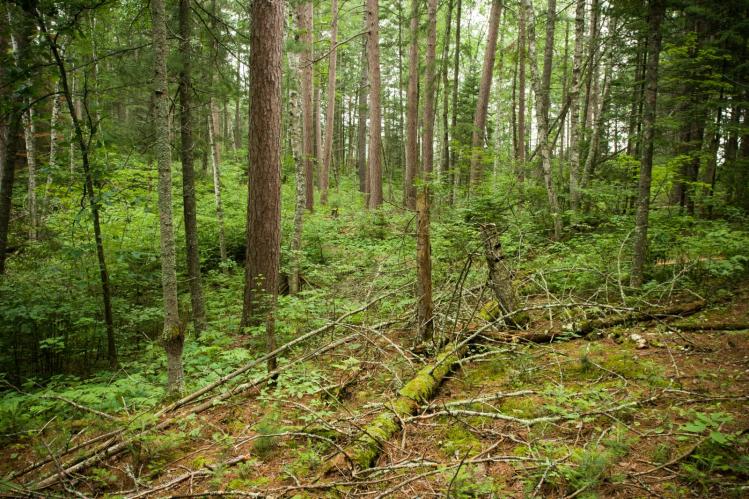
I usually come to places like this by myself. I assume that will make it easier for the Whatever it is I am looking for to find me and make everything okay. But I asked my fifteen-year-old daughter to come along with me today, because I thought it might make me feel less alone. I never expected her to be my John the Baptist, telling me a truth from the wilderness as if my life depended on it.
We stand in a virgin forest in northern Minnesota called the Lost Forty, which escaped the voracious teeth of logging saws because of a mapping error. These pines did not end up as telephone poles in Kansas or as masts at the bottom of the Atlantic. They have stretched toward the sun since before the Civil War.
Even though it’s almost April, my daughter sinks into hip-deep snow when she steps off the trail to throw her arms around the biggest tree we’ve encountered yet. When she presses her cheek to its rugged bark, I get my first inkling she knows something that I do not. I’m ready to press on. “We need to go,” I say. Why? There is no good reason. My daughter, on the other hand, has entered into a covenant with the wild: you be, I’ll pay attention.
I look around. These trees stand so straight they line up like rough pencils inside a blue box. Loggers ignored these trees a hundred years ago. Greed, speed, and noise ignore them now.
Enough dawdling. “Let’s see where this trail leads,” I tell my daughter. Before long, we spy a brown lump. The snow around the dead owl, which is the size and shape of a seal pup, is undisturbed. The bird must have literally dropped out of the red pine. I leave the trail to get a closer look at it, and the deep snow eats my legs. The owl has no visible wounds or signs of age, only a fractal beauty, and the creature looks so healthy and whole that I have to ask, “It is dead, isn’t it?” My daughter joins me, and we both bend down to stare at the owl. The breeze that ruffles its feathers makes it look as if the creature were breathing. “Yes,” she says. “It has to be.”
We walk on—my daughter whistles. I brood on the dead owl, as if it might impart some lesson. The owl doesn’t flee from this forest or this moment. It isn’t crippled by doubt or driven by the restlessness that more often than not leaves me thrashing. Some days I can barely keep my head above water. The question “What’s the point?” keeps pulling me down. Take this owl. Something beautiful, now inexplicably dead. I think about a child in a coffin, a gun in a school, an eye in a storm as big as Ohio. Where was—where is—the Whatever to make it okay?
My daughter and I find ourselves by a small trail that juts to the right. We take it and it leads us to another giant tree and a hill. From the wide and open marsh below, we hear a rhythmic trill. “Is that a frog?” my daughter asks. It is almost April, but because we are surrounded by so much snow, that feels cold-tomb impossible. We stand in snow and sun. I want to turn back toward the owl, but my daughter links her arm in mine and spins me toward the marsh again. The two of us stand, the sun on our faces, and she puts her head on my shoulder. I do not run or thrash. I pay attention to the feel of her, to my face that is warm from sun and cold from wind, to the sounds of new life rising. I pay attention to the truth my daughter is telling me. It matters where and how we look.
Please email comments to [email protected] and join the conversation on our Facebook page.
Share
Previous Story
The Rich Keep Themselves Rich
Next Story
Mass Murder & the Philippine Church